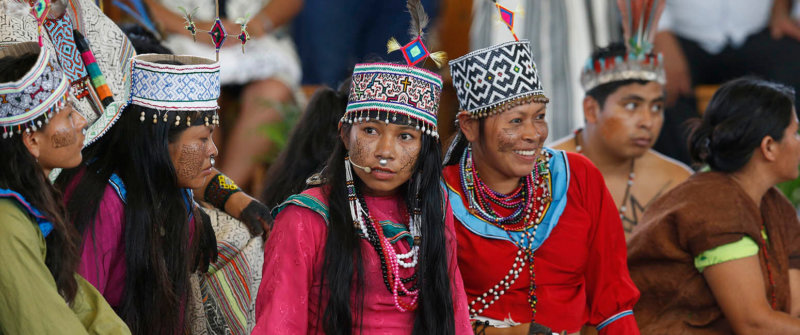LIMA, Peru — More than 1,000 young pilgrims will share their cultures, joys and struggles at a gathering of indigenous youth in a small town in Panama just before World Youth Day in January.
They are likely to be joined by several thousand local indigenous people, who will make the journey on foot or horseback, carrying food with them and setting up camp at the gathering place as is the custom during traditional assemblies, said Father Joe Fitzgerald, a Vincentian missionary from Philadelphia who heads the Panamanian church’s national indigenous ministry office.
“This will be an encounter with the Lord through our culture,” Emilda Santos, 20, who is Ngabe and one of the event’s coordinators, told Catholic News Service.
The gathering will take place Jan. 17-21 in the Ngabe territory of Soloy, in the Diocese of David, in western Panama. Father Fitzgerald, 48, has worked in the Soloy mission parish since 2007.
The participants also will take part in World Youth Day Jan. 22-27 in Panama City.

At the indigenous event, participants will reinforce their identity by sharing traditional music and dance and dramatizations of the struggles they have encountered, Santos said.
“We want to free ourselves from social exclusion and also from religious exclusion,” because in society and even in the church, “indigenous people are often marginalized,” she said.
Mini-pilgrimages during the event will enable the young people to explore and share their indigenous heritage. One will take them to a traditional cemetery and ritual cave, another to a village, and a third to a plant nursery, where they will prepare 5,000 seedlings to be sown later, when the rainy season begins.
This first international indigenous youth encounter echoes the themes of the 2016 World Youth Day in Krakow, Poland, where Pope Francis urged young people to “press forward, not only cherishing the memory of the past, but also with courage in the present and hope for the future.”
It also will come a year after the pope met with Amazonian indigenous people from Bolivia, Peru and Brazil during his visit to Peru in January 2018 and asked them to give the church an indigenous face by helping bishops, religious and lay workers understand their cultures and worldviews.
The logo for the event combines the cross of Jesus with a “penca,” a traditional open-sided, palm-thatched dwelling; cacao and corn, sacred plants for many indigenous peoples in Mexico and Central America; a chameleon, representing the diversity of creation; and plant roots reaching into the earth that Pope Francis calls “our common home.”

After the pope announced that the 2019 World Youth Day would be held in Panama, home to seven native peoples, the idea of a gathering of indigenous youth before the main event took shape during meetings of members of indigenous ministry teams in Central America and Mexico, Father Fitzgerald said.
The event is open to indigenous, native or aboriginal peoples from any part of the world, though early inquiries have come mainly from the Americas and Australia.
The Ngabe territory of Soloy is Panama’s largest indigenous territory, or “comarca.” The parish center is easily accessible by road for pilgrims traveling from North America and Central America to the main event in Panama City, although most of the comarca’s villages are reachable only by foot or on horseback, Father Fitzgerald said.
The event comes at a time when indigenous people in various parts of the world, including the Americas, increasingly face harassment and sometimes physical attacks for defending their territories. Besides reinforcing the participants’ pride in their identity, the gathering is meant to encourage young people to take leadership roles in their communities and countries, he said.
After the gathering in Soloy, the young people will continue their pilgrimage to Panama City for the World Youth Day events. That is the same route taken by many indigenous teens and young adults who leave their comarcas in search of better opportunities for work or studies in the city.
Once there, however, urban indigenous youths face obstacles, said Jeroncio Osorio, 19, a young Guna man who is studying administration at the National University of Panama in Panama City.
“It’s hard to find work when you don’t have experience,” said Osorio, who helps with indigenous ministry workshops for young people in the city.
During World Youth Day the young indigenous pilgrims will set up a native village in a Panama City park, with music, dance, traditional handcrafts and presentations highlighting their cultures, which often become invisible when they move to the city.
The encounter also will give the indigenous young people a chance to reflect on the relationship between their Christian faith and their traditional religion, said Eidigili Valiente, 23, Osorio’s sister, who is in her last year of studies at the National University of Panama.
Indigenous ministry workshops in Panama and other Central American countries have shown her parallels between events in the Bible, especially the Old Testament, and traditional Guna stories, Valiente said. Both include stories of the creation of the first human couple and of a devastating flood, she said.
Since migrating to the city as a teenager, Valiente said she has learned to stand up for herself and for other indigenous young people when people questioned their abilities. When she began studying psychology, she was the only indigenous student in the class.
Although “as an indigenous person, (sometimes) you’re afraid,” she said, she won her peers’ respect by talking openly about her culture and by pride in her ability to speak not only Spanish, but also Guna and some English.
“If you don’t respect yourself, if you don’t love yourself for being Guna, for being indigenous,” she said, “who’s going to do it?”
Copyright ©2018 Catholic News Service/U.S. Conference of Catholic Bishops.


